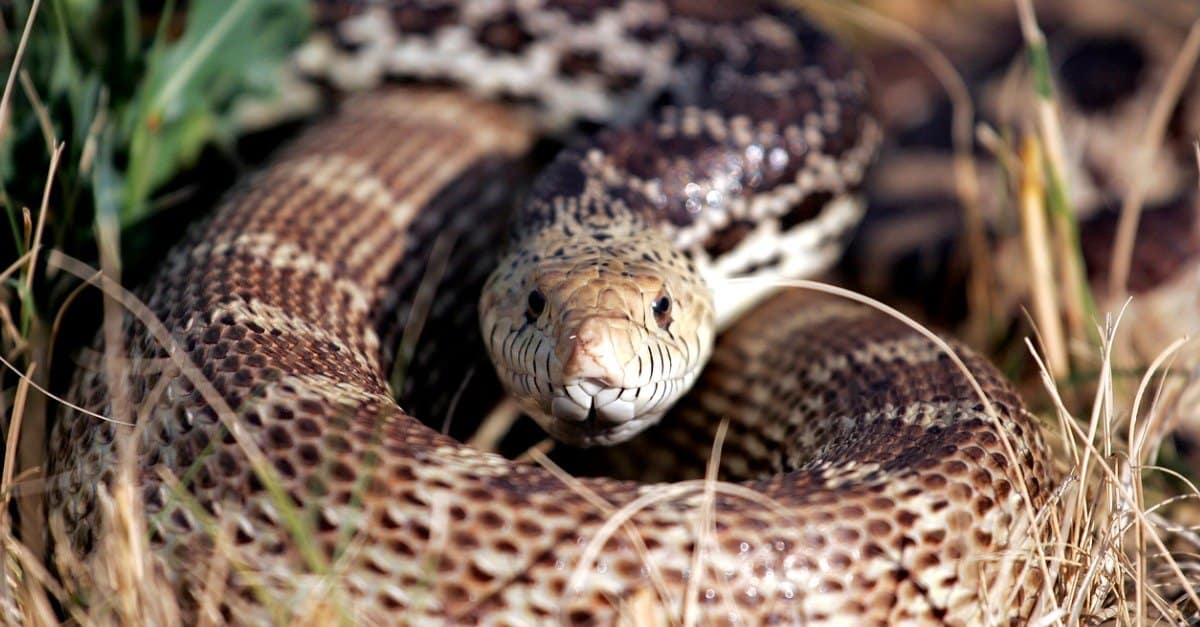Prairies are extensive temperate grasslands, primarily found in the lowland areas of North America. They are composed of grasses, herbs, and shrubs and typically receive moderate rainfall. But a prairie is more than just grass; it contains diverse wildlife dependent on its resources. One such animal is the snake. Snakes use tall grass to hide from predators and to find prey. Here’s a preview of the snakes we will discuss:
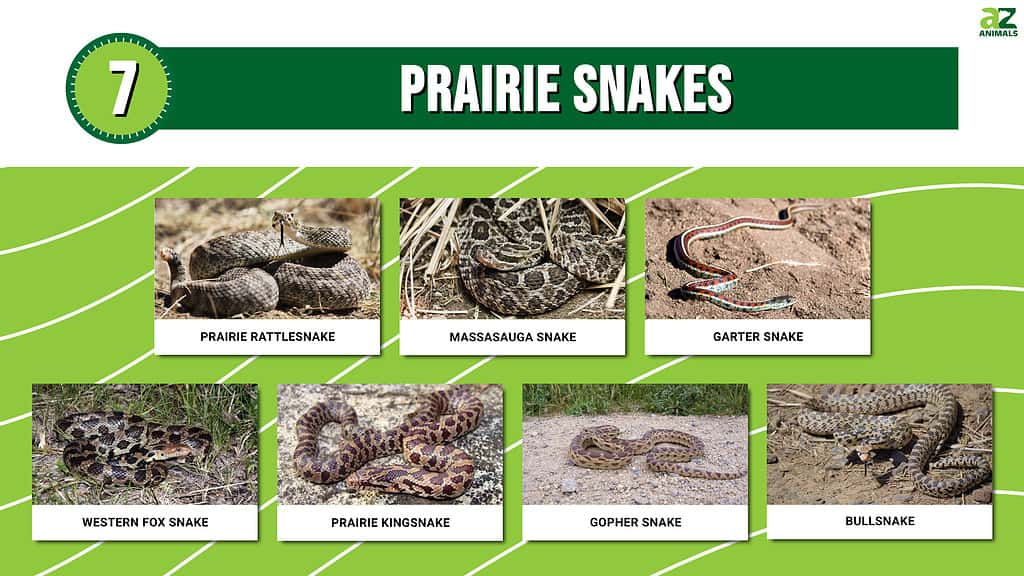
Read on to discover more detail about these seven prairie snakes and how they use their habitat to benefit themselves.
1. Prairie Rattlesnake
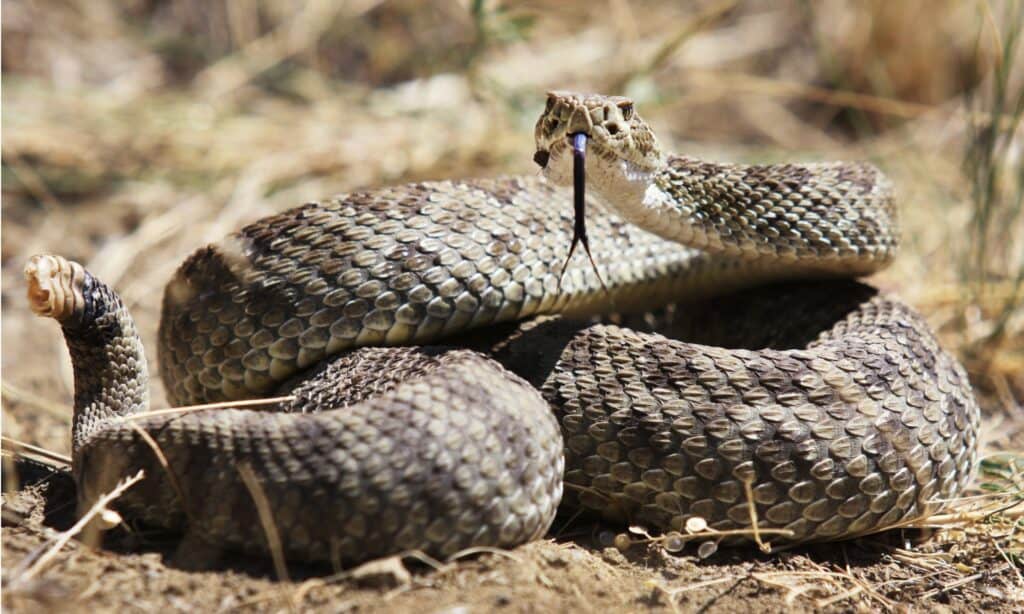
Prairie rattlesnakes are highly venomous and live in the Great Plains of the United States.
©iStock.com/HRossD
The prairie rattlesnake, also known as the Great Plains rattlesnake, is a venomous pit viper native to the Western United States and some parts of Canada and Mexico. These snakes are typically light-colored in hues of brown, meant to conceal them in their habitat. They grow between three and four feet long and feature their infamous rattle, which they use to deter potential predators. Be careful where you step! These vipers will use their potent venom when they are frightened or defending their territory.
As their name suggests, you can find them over much of the Great Plains, the eastern foothills, and valleys near the Rocky Mountains. These rattlesnakes inhabit areas with moderate vegetation and plenty of prey. During the hot summer months, they hide in burrows, crevices, and caves, and during cooler days, you can find them slithering on the ground preying on small mammals or occasionally climbing trees and bushes.
2. Massasauga Snake
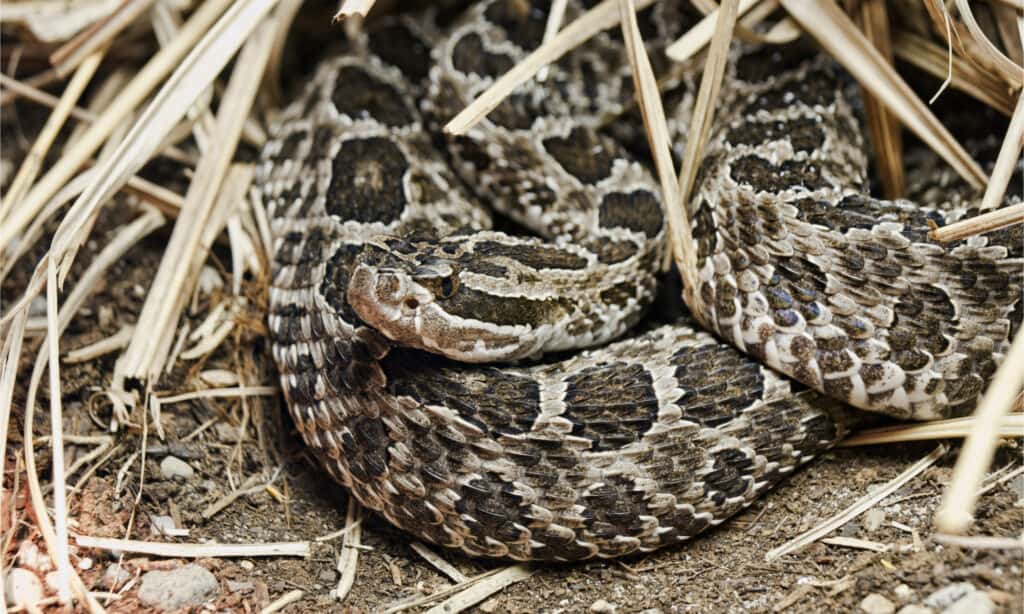
Massasauga rattlesnakes live in the prairies of Upper Missouri.
©DnDavis/Shutterstock.com
The Massasauga is a rattlesnake primarily found in the midwestern portion of the United States, from Canada to Mexico. These venomous snakes are gray or tan with dark brown spots and typically grow over two feet. Their fangs contain cytotoxic venom, which destroys the tissue and contains enzymes that prevent blood clotting. However, these snakes are shy and avoid humans at all costs. Bites are rare and only happen when people try to handle or accidentally step on them.
These rattlers are common in Ontario, Canada, and many areas of the United States, from the Northeast to the Southwest. They have a wide-ranging habitat, from swamps to grasslands, but are generally in the prairies of Upper Missouri. They like to inhabit areas with plenty of vegetation, so be careful when walking through areas with low visibility.
3. Garter Snake

Garter snakes are one of the most common reptiles in North America, with a wide-ranging habitat.
©Simone O/Shutterstock.com
These small to medium-sized snakes are native to North and Central America, with a wide-ranging habitat. There are over 35 garter snakes; most have large, round eyes, slender bodies, and longitudinal stripes (although some may have spots or nothing). Most people don’t realize that garter snakes have a mild venom they use to subdue prey. They are generally harmless to humans but may bite when provoked, causing swelling and bruising.
They are one of the most common reptiles in North America, inhabiting most regions in the country. Some species are more aquatic than others, but you can typically find them near a water source. They like to live in grasslands near small ponds with tall grass, and you can also find them in forests, woodlands, and backyards.
4. Western Fox Snake
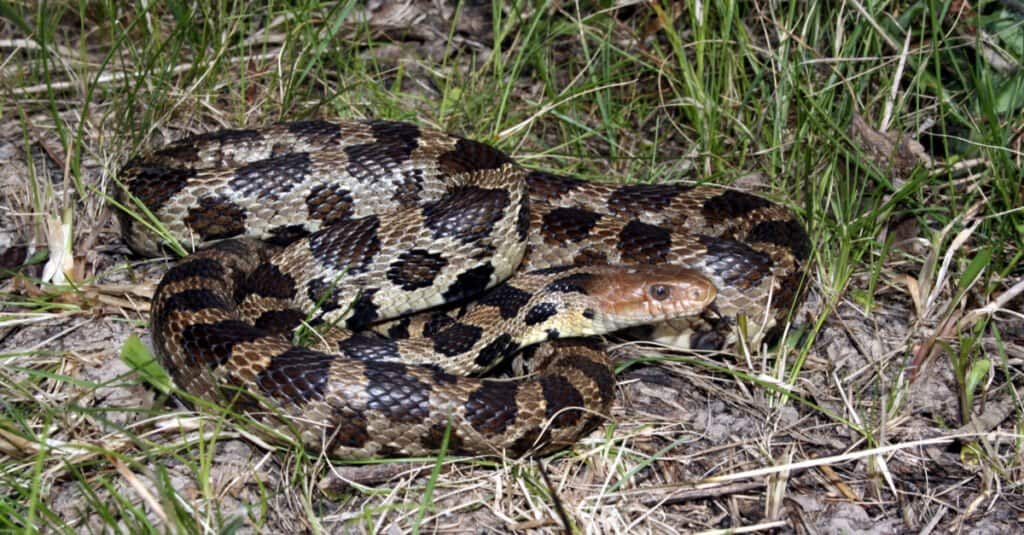
You can find the Western fox snake in the Upper Midwest.
©Psychotic Nature/Shutterstock.com
The Western fox snake is a rat snake endemic to the Midwestern United States. These nonvenomous snakes grow three to five feet long and typically have pale backs with dark brown or black splotches. They are constrictor snakes that squeeze their prey to subdue them. While these snakes are bold and live near humans, they are generally harmless as they do not contain venom.
You will find these rat snakes in the Upper Midwest, west of the Mississippi River, where they inhabit prairies, farm fields, and woodlands near rivers and streams. You will often find them in open grasslands or forest edges in Western Michigan, Iowa, Wisconsin, and Northern Illinois.
5. Prairie Kingsnake

Prairie kingsnakes live in open grasslands near a forested edge.
©Matt Jeppson/Shutterstock.com
The yellow-bellied kingsnake, or prairie kingsnake, is found primarily in the Midwestern and Southeastern United States. This prairie snake is light brown or gray with dark-colored splotches down the length of its body. It can grow over three feet in length and is often mistaken for a rat snake, which shares a similar environment. This snake is nonvenomous and pretty even-tempered around humans.
This species has a specific preferred habitat consisting of open grasslands near a forest edge with a nearby water source. The kingsnake is secretive and likes to hide in abandoned structures, underneath debris, or inside trees. It is relatively rare to see one in its natural habitat.
6. Gopher Snake

You can find gopher snakes in prairies in the Western United States.
©rawaccess/Shutterstock.com
The Western gopher snake is a nonvenomous colubrid (a family of snakes) endemic to North America. Many mistake the gopher snake for a prairie rattlesnake, but they are identifiable by their narrow heads and lack of black and white banding on their tail.
These snakes are rather large and grow to seven feet, and their coloring is yellowish or pale brown with dark blotches. The Western gopher snake is harmless to humans, rarely biting in the wild. Instead, it strikes with a closed mouth, using its snout to bump against predators.
You can find these snakes throughout the Western United States across various habitats, including prairies, deserts, coastal dunes, scrublands, and coniferous forests. They like to hide in burrows, trees, and low-lying vegetation. These solitary snakes like to live alone and mainly occupy ground spaces, but you can also find them climbing trees or swimming in nearby water sources.
7. Bullsnake
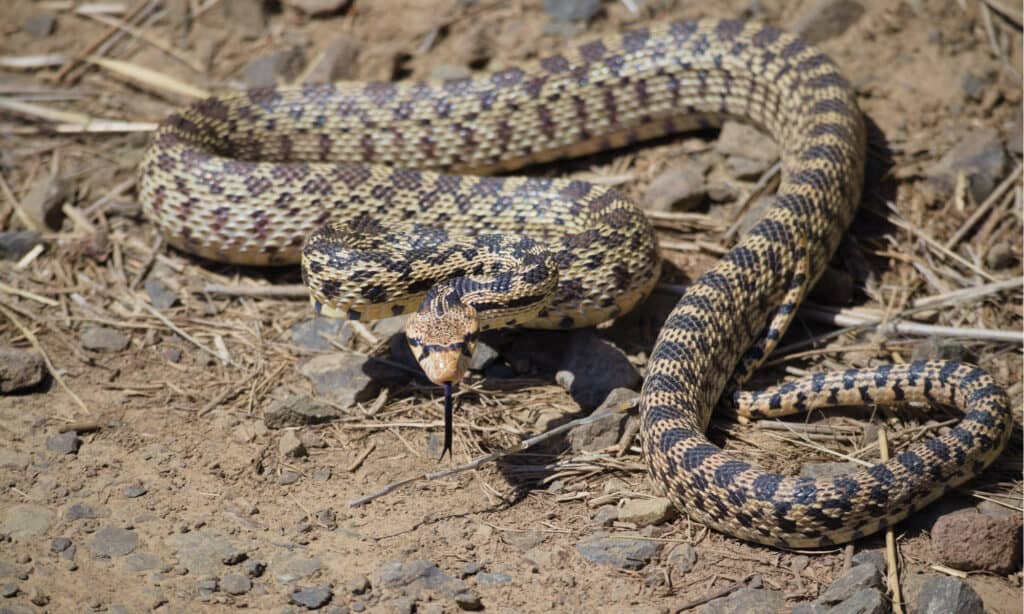
Bullsnakes are one of the largest snakes in North America.
©Christopher Joe Brown/Shutterstock.com
The bullsnake is a giant nonvenomous colubrid (a family of snakes) native to Canada, the United States, and Mexico. It is a subspecies of the gopher snake and one of the largest snakes on the continent, reaching lengths over eight feet.
It has many color variations, but most are yellow with white, black, or reddish blotches. Bullsnakes are pretty defensive and view humans as predators.
They can mimic rattlesnakes by puffing up their bodies, hissing, and shaking their tails. And while their fangs don’t contain venom, they can still inflict a painful bite.
Bullsnakes occur primarily throughout the Great Plains in the Midwestern United States. They like the open country where they can burrow underground but have a wide-ranging habitat. You can find them in native prairies, old fields, coniferous forests, woodlands, and oak savannas.
Other Reptiles and Amphibians That Live on the Prairie
Eastern Collard Lizards
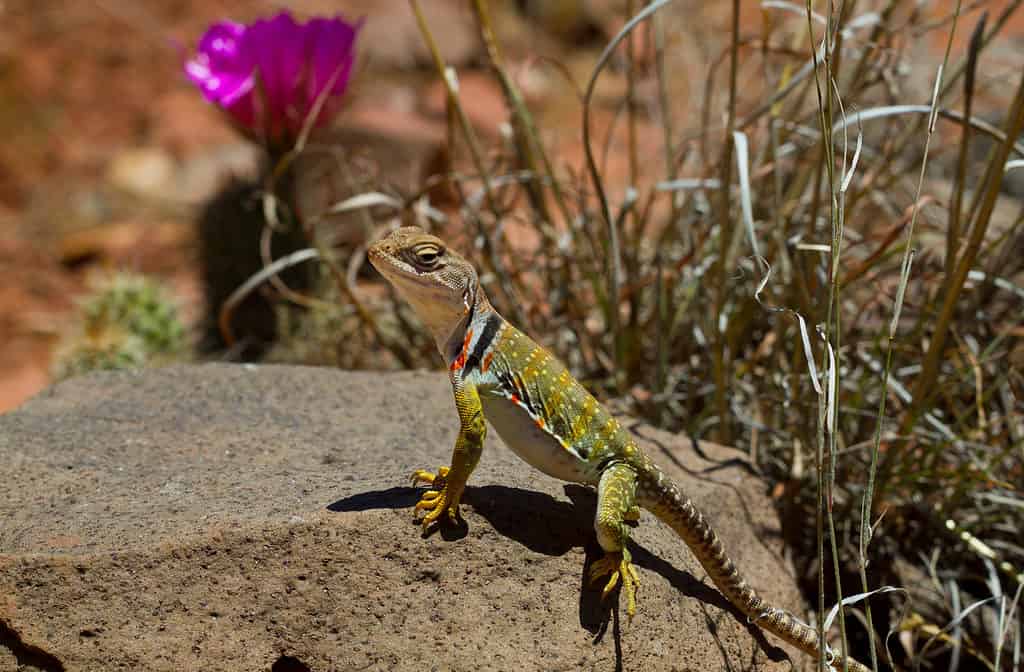
Eastern collared lizards are capable of growing to 11 inches and consume everything they can swallow
©Patricia Bouweraerts/Shutterstock.com
Territorial and voracious, these predators can be recognized by their large heads and double black bands at their necks. They may also have alternating bands of yellow, black, green, or white, all of varying thicknesses.
Yellow Mud Turtles

Yellow mud turtles prefer ponds and wetlands and are capable burrowers
©Kayla Blundell/Shutterstock.com
These reptiles can be recognized by their pale brown shells, grayish limbs, and yellow chins. They are capable of growing to 6 inches and prefer living in ponds and wetlands. They estivate during warmer weather and are capable of burrowing in the ground. Yellow mud turtles are omnivores and live on amphibians, aquatic flora, fungi, and insects.
Summary of 7 Prairie Snakes:
| Snake Species | Length | Venomous or Not | Location |
|---|---|---|---|
| Prairie Rattlesnake | 3-4 ft. | Venomous pit viper | Western Canada, United States, and Mexico |
| Massasauga Snake | 2+ ft. | Cytotoxic venom | Mostly upper Missouri, but across Midwest from Canada to Mexico |
| Garter Snake | 1.5-2+ ft. | Mild venom for prey | North and Central America |
| Western Fox Snake | 3-5 ft. | Nonvenomous rat snake; Constrictor | Upper Midwest: western Michigan, Iowa, Wisconsin, and Northern Illinois |
| Prairie Kingsnake | 3+ ft. | Nonvenomous | Midwest and Southeast United States |
| Gopher Snake | Up to 7 ft. | Nonvenomous colubrid | Western United States |
| Bullsnake | 8+ ft. | Nonvenomous colubrid, but painful bite | Canada, United States, Mexico |
Discover the "Monster" Snake 5X Bigger than an Anaconda
Every day A-Z Animals sends out some of the most incredible facts in the world from our free newsletter. Want to discover the 10 most beautiful snakes in the world, a "snake island" where you're never more than 3 feet from danger, or a "monster" snake 5X larger than an anaconda? Then sign up right now and you'll start receiving our daily newsletter absolutely free.
Thank you for reading! Have some feedback for us? Contact the AZ Animals editorial team.

